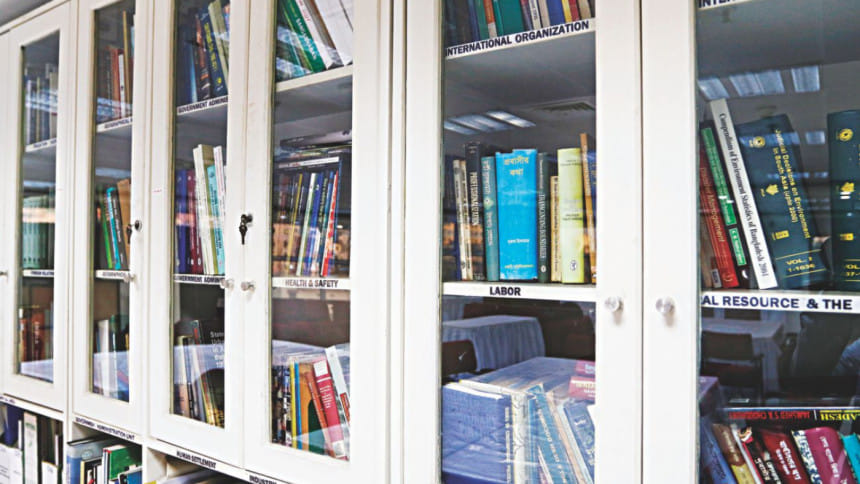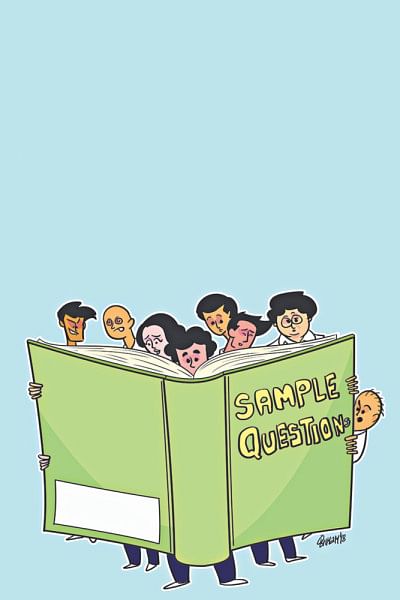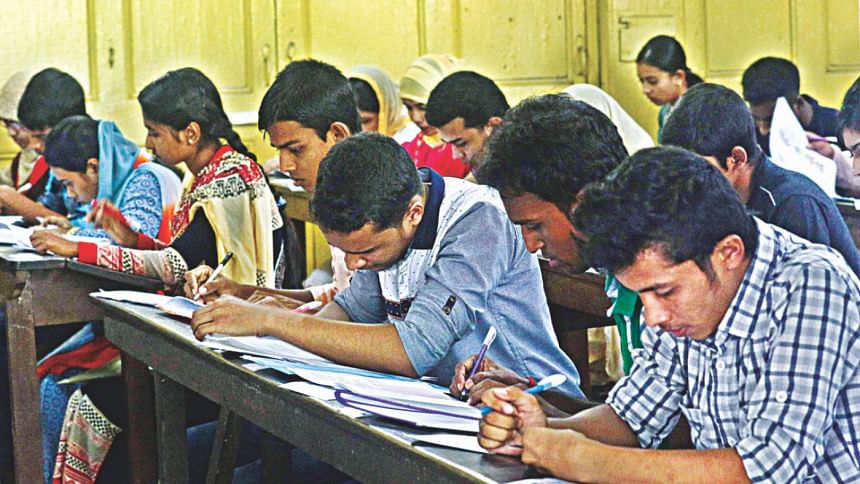An Integrated Admission Test in Public Universities of Bangladesh


PART I:
My batch and I sat for the HSC exam three decades ago in 1987. Our results came out at the end of that year. Like everybody else, I was faced with the question: which university, and what subject? I had no aspiration to study engineering or medical science. My choice was a general university. The only option open in those days was public universities. To our generation, private universities were unheard of.
Since a general university was my target, my choice was fixed. I had to decide from a chronological set: Dhaka (1921), Rajshahi (1953), Chittagong (1966), Jahangirnagar (1970) and Kushtia (1979). Even then, different universities held admission tests on different dates. Since there were only five general universities, there was no pressure on the university administrations to coordinate dates to avoid clashes. It was possible to attend admission tests of all five universities. Preparation was mainly done at home and consultation between friends solving guides. Coaching centres did exist, but they were mainly for engineering and medical admission tests. Student wings in universities would offer free coaching just before the exam in their universities.
The university admission test was different from today. SSC and HSC marks were given a weight in the total calculation. This weight differed from university to university. The next two components included a written test and an oral viva voce. Both these components were marked. Oral evaluation through a viva voce has almost disappeared today. Different universities had different rules for the written evaluation. Jahangirnagar took separate department-wise written and viva voce. Dhaka University written and viva voce was administered by the faculty (Units: A, B, C &D).
Optical Mark Recognition (OMR) machines were not available. Thus, the scope for setting MCQs to save time was limited. Teachers had to check scripts manually. The scripts were then scrutinized by another committee for cross-checking before results were published. The internet and mobile technology had not arrived in 1988. We found out about our results through national newspapers or from the notice board in the department or faculty of the university we applied to.
The admission process from the publication of the HSC results to the starting of classes was time consuming. At Jahanginagar, the 1987 HSC batch started classes on November 12, 1988. This was more than one year after publication of the HSC results. The other general universities started classes of the same batch at around similar dates. Before university students started classes, they were subject to a one-year session-jam. Technological improvement via OMR for evaluation and publication of results via the internet and SMS has reduced the time-lag. Yet, a significant lag of up to five months or more exists after HSC results and class starting.

PART II:
The 1990s was a watershed. Bangladesh re-embarked on parliamentary democracy in this decade. Whether that was the cause or not, since the 1990s, Bangladesh has also been experiencing economic growth. This has created a launching pad to become a middle-income nation. An emerging economy needs a youthful and educated population. Bangladesh needed time to overcome the devastations of the liberation war to make a 'take off' to quote a Rostowjargon. The stage was set for a proliferation of universities. The first private university started in 1992. Since then, the number of universities in the public and private sectors has been growing due to the demand for higher education by an ever-growing youth population in Bangladesh.
Today, in total, there are 120 universities in Bangladesh. Of these, 40 are in the public sector; and 80 (approved 92) in the private sector. Excluding the National University and the Bangladesh Open University that offer education in more than one campus, there are 28 universities that can be defined as the 5 general universities in 1987/88 offering education on one campus and are not exclusively an engineering, medical or other technical university. Much has changed since 1987/88. The time has now come to re-think admission tests in public universities in Bangladesh.
In 2017, a total of 801,711 candidates passed the HSC from ten boards in Bangladesh. Among them37,726 obtained a GPA of 5 (golden and non-golden). Excluding the National University and the Bangladesh Open University, the seat capacity to absorb the 2017 HSC Batch in the 28 general universities in the public sector was 47,636. Although their numbers in the application pool is small, these figures do not include students from O and A Levels who also apply to public universities.
Public universities try to coordinate to avoid time clash in their admission tests. Nevertheless, some time clashing is observed. Today, it is almost impossible for candidates to attend admission tests in more than say five universities. The cost of travel can drain the budget of most families. In the case of female candidates, a guardian has to accompany them. This contributes to further drainage on family budgets. It may also not always be possible for families to accompany female candidates. The choice of university and subject thus becomes constrained for both male and female applicants. Let us see a break-up of costs for a family.
Forms have become costly. Let us assume a student buys 10 forms of different units in different universities, and on average spends Tk 700 per form. This would mean Tk 7,000 in total. If the student is living away from the university, then travel, accommodation and food cost can easily be around Tk 5,000 per trip even at a conservative estimate. If guardians accompany female candidates, this cost can go up to Tk 8,000. Thus, if a candidate is sitting for admission tests in five universities, the cost for forms and travel can go up to Tk40,000 for each candidate. There are other costs many families incur.
There is no concrete evidence that coaching increases a student's likelihood of admission. Nevertheless, the general perception is that coaching is necessary to get admitted in a good subject in a good university. Coaching has a peer effect. If your friends are taking coaching, then you and your family also feel the need to do so. Thus, most university applicants attend coaching prior to admission tests. In many cases, students start coaching while they are college students preparing for HSC exams. Students face a double pressure: focusing on their HSC exams and also admission tests of desired universities. The problem manifolds with the better coaching centres located in Dhaka and other metropolitan centres. Students incur a commuting cost and in some cases accommodation costs for few months. Discussing with students of Jahangirnagar, it was found that coaching centre costs amount to Tk 70,000 in three months in Dhaka. This Tk 70,000 includes coaching fees, boarding, books, and food only. If you add this with the traveling costs above, even at a conservative estimate, the minimum costs for a university applicant will cross Tk 1 lac. Few families can bear these costs from current income. The majority of families pay from past savings or from loans.
If an integrated university admission test (IUAT) were possible to implement, it would have multi-dimensional benefits. The admission tests can be held within two months of the publication of HSC results. Students would need to purchase only one admission form. Since there are public universities throughout the country, a student in a remote place will incur minimum travel and other costs to sit for the admission test. Reducing or eliminating travel hassle out of the equation will have an important additional benefit. It will encourage female candidates to embark higher education more than they are now.

PART III:
Implementing an IUAT is always easier said than done. Any new policy comes at a cost of changing or disturbing the existing status quo. There are statutory constraints. The public universities are not under one single Act or Ordinance. The 1973 Act gives significant autonomy to the universities of Dhaka, Rajshahi, Chittagong, and Jahangirnagar. Other universities follow different Acts and Ordinances. Most of the Science and Technology Universities function as a general university offering non-technical subjects in their undergraduate and graduate programmes.
Presently, separate university admission tests generate handsome remuneration packages for teachers, officers and other staff. This remuneration package surpasses Tk 1 Lac for each recipient in some universities for maximum ten days in vigilation. This money-incentive acts as a deterrent for universities to participate in an IUAT because the existing financial benefit will almost certainly drastically fall under an IUAT.
The University Grants Commission (UGC) started a dialogue on an integrated university admission test in 2008. In July 2013, many Vice Chancellors agreed in principle that public universities need to move towards an integrated admission test. Since then, there has been a series of dialogues with no visible improvement. In 2015, Jessore and Sylhet Science and Technology Universities decided to hold an integrated admission test. This initiative did not see daylight. In November 2016, during presentation of the UGC Annual Report, the Honourable President requested to explore the possibility of an integrated university admission test. A ray of hope, nevertheless. A committee has been formed by the Ministry of Education and the UGC. Professor Abdul Mannan, Chairman of the UGC, heads the committee. The target is to start an IUAT from 2018.
There is another side of the coin. No matter how expensive and cumbersome multiple admission tests may be on applicants and their families, the existing system does have advantages. With multiple admission tests, students increase the likelihood of getting admission in at least one university. Any initiative towards a single admission test needs to take this into account. A test in the format of GRE may be arranged based on what students have learned till HSC. Students take the test at a public university nearest to them. In a span of one month or so, students can sit for this test more than once. They will submit their best performance in the IUAT.
An IUAT soon after HSC results may reduce dependency on coaching. Students will get a chance to sit for a test more than once from their desired location in Bangladesh. This will save time and drainage on the budgets of applicants' families. The problem lies in getting the public universities to agree to an IUAT and finding an acceptable formula.
CONCLUSION
The objective of this discussion was not to propose a formula on how to move towards an IUAT. A formula will be devised by policy makers and executives. The objective was to show the necessity of an IUAT in public universities in Bangladesh. The majority of applicants in the public universities come from non-affluent backgrounds. Investment in education and health have benefits that spillover from one generation to the next. This is why the public sector invests heavily in education and health in most countries. Bangladesh is on the brink of moving towards a middle-income nation. A middle-income nation will need an educated workforce to make a 'take-off'. Since public universities are funded and subsidized by the State, they have a moral responsibility towards the mass people of Bangladesh. Whether an initiative towards an IUAT will see day light is for time to tell. That an IUAT is a burning issue is more than overdue.
Special Thanks to Mr. Md. Monir of Batch 41, Department of Economics, Jahangirnagar University for his valuable discussions in writing this article.
Asrarul Islam Chowdhury is a Professor in Economics at Jahangirnagar University. He contributes in the Echoes column in Shout of the Daily Star. He can be reached by email: [email protected]

 For all latest news, follow The Daily Star's Google News channel.
For all latest news, follow The Daily Star's Google News channel. 



Comments